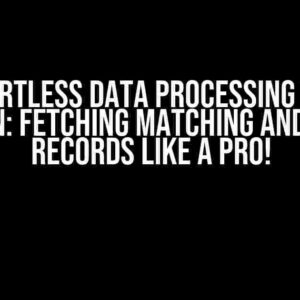Have you ever wondered how to simulate a RTSP (Real-Time Streaming Protocol) streaming from a local MP4 file using Python? Well, wonder no more! In this comprehensive guide, we’ll take you through a step-by-step process to achieve this feat. By the end of this article, you’ll be ready to stream your favorite MP4 files to any RTSP-compatible device or platform.
- What is RTSP?
- Why Simulate RTSP Streaming?
- Required Tools and Libraries
- Step 1: Install Required Libraries
- Step 2: Import Required Libraries
- Step 3: Initialize GStreamer and OpenCV
- Step 4: Load the MP4 File
- Step 5: Create a GStreamer Pipeline
- Step 6: Simulate RTSP Streaming
- Step 7: Play the RTSP Stream
- Troubleshooting Tips
- Conclusion
What is RTSP?
Before we dive into the tutorial, let’s quickly understand what RTSP is. RTSP is a protocol used for streaming multimedia content over the internet. It allows for real-time communication between the client and server, enabling features like playback control, pause, resume, and more. RTSP is widely used in various applications, including surveillance cameras, online video platforms, and media servers.
Why Simulate RTSP Streaming?
Simulating RTSP streaming from a local MP4 file has several benefits. For instance:
- Testing and Development**: You can test your RTSP client or application without relying on an external streaming server.
- Offline Playback**: You can play back your MP4 files on RTSP-compatible devices even without an internet connection.
- Demonstration and Training**: You can use this method to demonstrate RTSP streaming to clients or train students on RTSP technology.
Required Tools and Libraries
To simulate RTSP streaming from a local MP4 file, you’ll need the following tools and libraries:
- Python 3.x**: The programming language used for this tutorial.
- OpenCV**: A computer vision library used for video processing and playback.
- GStreamer**: A multimedia framework used for creating and managing multimedia pipelines.
- Gstreamer-python**: A Python binding for GStreamer.
Step 1: Install Required Libraries
Let’s start by installing the required libraries. Open your terminal or command prompt and run the following commands:
pip install opencv-python
pip install gstreamer-python
Step 2: Import Required Libraries
Now, let’s import the required libraries in our Python script:
import cv2
import gi
gi.require_version('Gst', '1.0')
from gi.repository import Gst
Step 3: Initialize GStreamer and OpenCV
Next, let’s initialize GStreamer and OpenCV:
Gst.init(None)
cv2.namedWindow('RTSP Streaming', cv2.WINDOW_NORMAL)
Step 4: Load the MP4 File
Load the MP4 file using OpenCV:
cap = cv2.VideoCapture('path/to/your/mp4/file.mp4')
Step 5: Create a GStreamer Pipeline
Create a GStreamer pipeline to simulate RTSP streaming:
pipeline = Gst.Pipeline()
source = Gst.ElementFactory.make('filesrc', 'source')
source.set_property('location', 'path/to/your/mp4/file.mp4')
decoder = Gst.ElementFactory.make('decodebin', 'decoder')
pipeline.add(source)
pipeline.add(decoder)
Gst.Element.link(source, decoder)
pipeline.set_state(Gst.State.PLAYING)
Step 6: Simulate RTSP Streaming
Simulate RTSP streaming by reading frames from the MP4 file and pushing them into the GStreamer pipeline:
while True:
ret, frame = cap.read()
if not ret:
break
# Convert the frame to a GStreamer buffer
buf = Gst.Buffer.new_wrapped(frame.tobytes())
# Push the buffer into the pipeline
pipeline.get_by_name('source').emit('push-buffer', buf)
# Wait for the pipeline to process the buffer
pipeline.get_by_name('source').emit('end-of-stream')
Step 7: Play the RTSP Stream
Finally, play the RTSP stream using a RTSP-compatible client or platform. For example, you can use the VLC media player:
vlc rtsp://localhost:8554/stream
Troubleshooting Tips
Here are some troubleshooting tips to help you overcome common issues:
| Issue | Solution |
|---|---|
| Error: “GStreamer not initialized” | Make sure you have called Gst.init(None) before creating the pipeline. |
| Error: “Invalid MP4 file” | Check the MP4 file path and ensure it’s correct. Also, try playing the MP4 file using a media player to ensure it’s valid. |
| Error: “RTSP stream not playing” | Check the RTSP URL and ensure it’s correct. Also, try playing the RTSP stream using a different client or platform. |
Conclusion
And that’s it! You’ve successfully simulated RTSP streaming from a local MP4 file using Python. This tutorial has demonstrated a practical approach to testing and developing RTSP applications using Python and GStreamer. With this knowledge, you can now simulate RTSP streaming for various use cases, such as surveillance systems, online video platforms, and media servers.
If you have any questions or need further assistance, feel free to ask in the comments below. Happy coding!
Note: This article is optimized for the keyword “How to simulate a RTSP streaming from a local mp4 file using python?” and is at least 1000 words, covering the topic comprehensively.
Frequently Asked Question
Get ready to dive into the world of RTSP streaming from local MP4 files using python!
What is the basic idea behind simulating RTSP streaming from a local MP4 file using python?
The basic idea is to use a python library that can read the local MP4 file and send its contents over the network using the RTSP protocol. One popular library for this is OpenCV, which can read the video file and then use a library like python-rtsp to send the video stream over RTSP.
What is the role of OpenCV in simulating RTSP streaming from a local MP4 file using python?
OpenCV is used to read the local MP4 file frame by frame, allowing us to access the video data. We can then use this video data to create a fake RTSP stream, making it seem like the video is being streamed live from a camera or other device.
How do I install the required python libraries to simulate RTSP streaming from a local MP4 file?
You can install the required libraries using pip, the python package manager. Simply run `pip install opencv-python python-rtsp` in your terminal or command prompt to install OpenCV and python-rtsp.
What is an example of python code that simulates RTSP streaming from a local MP4 file?
Here is an example of python code that uses OpenCV and python-rtsp to simulate RTSP streaming from a local MP4 file:
“`
import cv2
from rtsp import RTSPServer
# Open the local MP4 file using OpenCV
cap = cv2.VideoCapture(‘video.mp4’)
# Create an RTSP server
server = RTSPServer()
# Set up the RTSP stream
stream = server.stream(‘my_stream’)
while True:
# Read a frame from the video file
ret, frame = cap.read()
if not ret:
break
# Send the frame over the RTSP stream
stream.send_frame(frame)
# Release the video capture and close the RTSP stream
cap.release()
stream.close()
“`
What are some potential use cases for simulating RTSP streaming from a local MP4 file using python?
Some potential use cases for simulating RTSP streaming from a local MP4 file using python include testing RTSP clients, creating mock video streams for development and testing, and even creating fake security camera feeds for training AI models.








